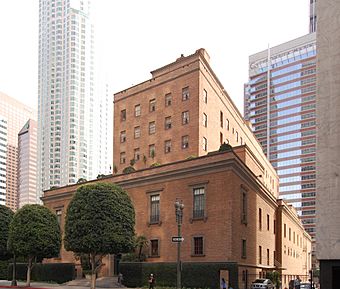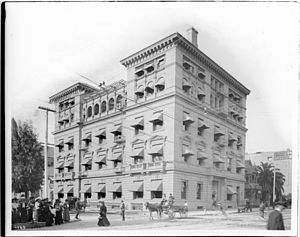California Club facts for kids
|
The California Club
|
|
 |
|
| Location | 538 S Flower St, Los Angeles, California |
|---|---|
| Area | Less than 1 acre (0.40 ha) |
| Built | 1929–1930 |
| Architect | Robert D. Farquhar |
| Architectural style | Italian Renaissance Revival |
| NRHP reference No. | 10000425 |
Quick facts for kids Significant dates |
|
| Added to NRHP | July 6, 2010 |
The California Club is a special private club in Los Angeles, California. It was started way back in 1888. To join, you need to be invited by current members. It's known as one of the most exclusive clubs in the United States.
Many important people in Los Angeles have been members of the California Club. To become a member, you need invitations from at least six current members. You also go through interviews and background checks. This makes sure new members fit in with the club's traditions.
In 2005, a researcher from University of California, Santa Cruz studied social clubs. He ranked the California Club as the 13th most important club. It was also called the third most exclusive private club in the country.
How the Club Started
The California Club officially became a club on December 24, 1888. The very first meeting to plan the club happened on September 24, 1887. At this meeting, they decided to call it the California Club of Los Angeles. They also set up the first rules for how the club would work.
The club's first home was on the second floor above the Tally-Ho Stables. This was near First and Fort (now Broadway) streets. Later, in 1895, the club moved to the Wilcox Building. It took up the top two floors, the fourth and fifth. This building was special because it had two elevators. One was for the public, and the other was just for club members.
As more people wanted to join, the club needed a bigger space. So, in 1904, the club moved again. This time, it moved to a five-story building located at Fifth and Hill streets.
For many years, the California Club had rules about who could join. These rules meant that women, African Americans, and Jewish people were not allowed to be members. However, in the 1980s, things began to change. In 1987, members voted to allow women to join. The Los Angeles City Council also voted to stop such rules at clubs in the city. Since then, the California Club has welcomed all people who meet its membership requirements.
The Current Clubhouse
The club's current building is seven stories tall. It was finished on August 25, 1930. Construction on this grand building started in late 1928. The famous architect Robert D. Farquhar designed it. He studied architecture in Paris, France. His design for the California Club building was so good that he won a special award for it.
The National Park Service describes the building as very important. It is built in the Italian Renaissance Revival style. This style looks like old Italian buildings. The club's building has special features like a private front area. This helps make the club feel private and elegant.
Because of its historical and architectural importance, the building was added to the U.S. National Register of Historic Places. This happened on July 6, 2010.
Inside the clubhouse, you can find beautiful old furniture and antiques. The walls are decorated with many paintings. These paintings show Western landscapes and outdoor scenes. They were created by famous American artists like J. Bond Francisco, Elmer Wachtel, and William Wendt.
See also
- List of American gentlemen's clubs
- Membership discrimination in California social clubs



